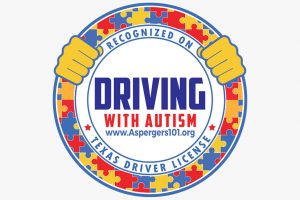Every inexperienced driver can get nervous when they first begin to drive. In the case of Aspergers drivers, those nerves jangle even more, as they take in a lot more stimuli in the driver’s seat. Tension arises due to many, and frequently simultaneous, stimuli input.

These include general anxiety, excessive sunlight, car and traffic noises (i.e. horns honking), bumps, high speed, and excessively high and low temperatures in the car. Any one of these stimuli potentially triggers meltdowns and panic attacks; not ideal when behind the wheel. Fortunately, there are methods to manage and control such stimuli to make them pleasant, instead of unpleasant.
First, allow the Aspergers individual to practice driving while paying attention to the stimuli that s/he finds most unpleasant and pleasant. Then, make a plan to control it all.
Temperature and Light
With regard to stimulus management, simple adjustments often provide the necessary resolutions. For example, climate control adjusts temperature, while sun visors and sunglasses can protect against excessive sunlight and glare.
In the case of night driving, excess light comes in the form of headlights of oncoming vehicles. Looking away and using the road lines helps, as long as the driver pays attention to traffic, signs, and lights as well.
Seatbelt
Another example is an Aspergers driver refusing to wear a seatbelt because of great tightness or the feeling on the skin. The solution there is to wear the belt so that it secures to the driver’s waist, but has little or no contact with the skin.
Traffic Noise
Other issues have greater complexity; therefore, they take more time and effort to overcome. For the issue of traffic noise, an Aspergers driver receives numerous inputs at once; these often overwhelm the driver to the point where they put him/her in danger.
To resolve this, a parent can introduce to his/her Aspergers son/daughter various stimuli, such as horns honking, loud motors, screeching tires, and more in order to help them to acclimate to them. Instead of avoiding the unpleasant stimuli altogether, the supervising front passenger and/or the Aspergers driver can allow him/herself to indulge them in a step-by-step, experienced-based manner. In other words, the more experience a driver gets, the more s/he becomes adept to the simultaneous input of various stimuli while driving.
In time, the driver will not give a second thought to the various stimuli around him/her and will develop the ability to integrate them together to form a clearer picture as s/he takes to the streets.
By Reese Eskridge

Reese Eskridge is a Production Technician with Fairville Products, who is passionate about working in the sciences (biology) and wishes to take his work experiences further into the fields of Educational Neuroscience; Science Fiction; Freelance Writing; Disability Advocacy; Public Speaking; Leadership and Entrepreneurship. Reese is dedicated to sharing his personal experiences of living life on the spectrum to its fullest.
You may contact Reese at: reeseesk@udel.edu
Learn more about AS101’s “Driving with Autism” here!
Please consider donating to help support this initiative.
“Driving with Autism” is an Asp ergers101 series that educates and empowers the driver diagnosed with High-Functioning Autism or Asperger’s Syndrome. Aspergers101 has teamed up with the Texas DPS in training Texas State Troopers about the uniqueness of Autism and understanding the Autistic driver. This partnership is garnering encouraging results.
ergers101 series that educates and empowers the driver diagnosed with High-Functioning Autism or Asperger’s Syndrome. Aspergers101 has teamed up with the Texas DPS in training Texas State Troopers about the uniqueness of Autism and understanding the Autistic driver. This partnership is garnering encouraging results.
Gabriela Lemos was born in Porto Alegre, Brasil, and was raised in San Antonio, Texas. She is currently a student at UTSA, graduating in December 2014 with a Bachelor degree in English. Brie states that she loves language and words, and the way in which people communicate with each other. She has always been interested and attracted to the autism community. “I find those on the spectrum to be incredible in so many ways, and I believe we can all learn from each other in our different strengths and weaknesses. I would love to use my talents to aid those who are not as strong in areas which I have confidence, and in turn receive an infinite amount of lessons and aid from those who I work with. Everything you send out, comes back to you, and I plan to practice sending out love and compassion every day”. We feel so fortunate to offer Brie’s talent of writing as well as her passion for autism awareness every week through our Aspergers101 Weekly.


